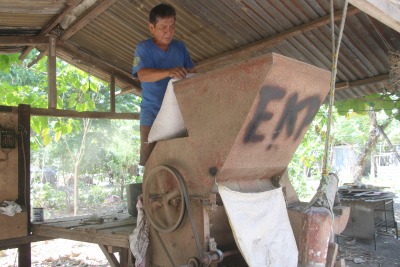Finding the right crop is a huge concern for enterprising farmers.
To many marginal hill farmers, making the right choice is even more made difficult by scant financing and lack of access to direct buyers.
It is in relation to profitability and financial sustainability that I am sharing this piece.
Yes, I decided to grow peanuts on the farm.
I was prepared though to settle for a little profit or even a slight loss because my main concern was to make better use of the portion of the farm that had been cleared, maintain minimal weed growth, and still allow me to plant more coconut and fruit trees.
After all, countries such as China, India, the USA, Nigeria, Sudan, Myanmar, and Argentina each produced millions of tons of unshelled peanuts in 2017 (FAOSTAT 2019).
Both online and offline sources are convincing in making the commodity an attractive choice for farming.
The market stalls are never without those peanut beans and peddlers daily sell fried peanuts and boiled fresh pods in General Santos City.
The grocery shelves constantly display those processed peanut products.
From time to time I saw sacks of peanut pods being hauled downhill via my farm for delivery to buyers.
There must be profit in growing the crop! But I had to know myself. I needed concrete data to confirm.
In a nutshell, I realized that those advantages I enumerated on another page (click here to read) are valid, all except one. Profitability.
Loss, however, did not come from all phases of peanut growing.
There were only two causal operations where labor cost was excessively high: threshing and shelling.
Peanuts Gone Nuts as Choice Crop: 1. Threshing
In harvesting, I employed 2 male uprooters and 8 women threshers (pod strippers) equivalent to a ratio of 1:4.
The former uprooted the peanut plants, shook them vigorously to remove the soil which adhered to the pods and roots, and piled the plants in small heaps.
The women separated the well-developed pods from the plants and dropped these into sacks.
It took 6 days to harvest with a yield of 6 1/2 sacked fresh pods or nuts.
Mean wet pod content was about 50 kg per sack.
Mathematics applied: 8 human threshers paid daily wages plus food, minus the market value of the sacked fresh pods, and the net income was negative.
The cost of seeds and those incurred in other operations including uprooting were not even included in the computation.

To test, I manually threshed a few days ago. Results confirmed the data.
Lesson: Threshing of peanut using paid human labor ensures financial loss.
Peanuts Gone Nuts as Choice Crop: 2. Shelling
Realizing that selling freshly harvested pods will ensure loss due to the high cost of manual threshing, I opted to dry pods and had these shelled using a mechanical sheller for a pay per kg of dry pods.
It only took about 1 hr for 4 sacks of dry pods to be shelled with a yield of 89 kg of seeds.
The pay was minimal, that is, equivalent to 3 days of wages for 1 farm worker or 3 farmworkers each paid 1 day of work.
In comparison, I recently shelled by hand dry pods of the Native White variety.
For 3 hours I only managed to produce 1.15 kg of shelled seeds or 0.38 kg per hour even though I consider myself skilled in peanut shelling.
Conversely, it took me 2.6 hr or 2 hr and 36 min to produce 1 kg of shell-free seeds.
Apply mathematics: Applying ratio and proportion with my own shelling rate as the basis, it would take about 232.17 hr for human shellers to yield 89 kg of seeds.
Consequently, 29 human shellers would be needed to complete the shelling of 4 sacks of dry pods in one day at 8 hours per day.
Lesson: Paid manual shelling will surely be a financial disaster.
Remedial Measures, Business Opportunity Too
To grow peanut for profit, the procurement, fabrication, or rental of an efficient mechanical thresher or pod stripper at a reasonable price should take primacy.
The equipment should be more important if the pods or nuts are to be marketed fresh for boiling.
It should be gasoline- or diesel-driven, or even pedal-driven, and portable to allow deployment on the farm.
It can thus be rented to accessible farms.
Access to a mechanical sheller at reasonable pay will also allow the farmer to exercise options of whether to sell the produce as pod or seed.
If the produce is intended for marketing as seed, such an equipment should prove cost efficient.
It does not necessarily mean, however, that a farmer should completely forgo peanut production as a cash crop in the absence of a thresher.
In such case, production should be minimal and intended for marketting as dry seeds.
The farm plan should include uprooting of mature plants, drying, and piling where there is rain shelter.
Manual threshing (also shelling) can be done by the farmer himself or members of the family during their spare time.
Provided, however, that the farmer is not in immediate need of cash.
The threshing I did myself and I felt satisfaction for having made better use of my time including nighttime.
Although farmer’s and family labor should be entered in the books as cost in raising a peanut crop, I did not mind it so much.
The important thing was that I was able to keep the money which would surely become a loss if I hired human thrashers.
Instead, I myself earned the wages appropriated for threshing.
A Strategic Call to Promote Peanut Farming : Use mechanical thresher and sheller in growing peanut as a cash crop.
Literature Cited
FAOSTAT. 2019. Production: countries by commodity. Retrieved Feb. 26, 2019 from http://www.fao.org/faostat/en/#rankings/countries_by_commodity.
